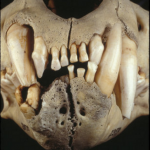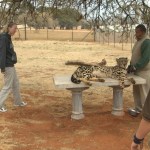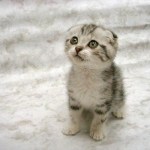Carnivora
I'll never forget my first lion.
A colleague and I had just arrived in the Semliki Valley, in the Congo, to a part of that valley then known as the most predator-rich region of Africa, with loads of lions and heaps of hyenas. Lots of leopards too. We arrived at the main base camp for a large expedition that I was to join a year later (this was a brief visit) and were told to find the satellite camp, out in the bush.
"Ten clicks that way, then a left on their road. Good luck finding the road."
Good luck indeed. Took us forever. And, at one point, after night fell, we had the brilliant idea…
Since it is Caturday, and I don' think I've posted these before.
A King Cheetah (a rather large form of cat) in South Africa:
King Cheetah (cat)
Closer in on the King Cheetah, South Africa
Picture Of Cat On Top Photo Credit: Gatto Mimmo via Compfight cc
Why would you want a field guide to all of the carninvores? They live everywhere, so there is no reason to carry around a field identification guide with ALL of them unless you were going everywhere in the whole world on one trip!
Yet, there is such a field guide, Carnivores of the World (Princeton Field Guides), and the truth is, this is ONE OF THE COOLEST BOOKS I'VE EVER SEEN! All the carnivores (almost) in one book. Interestingly, it turns out to be possible. There are fewer than three hundred species of terrestrial carnivore in the whole world, and that is fittable in a single book…
Cuddly Cub Polar Bear Knut has died unexpectedly, at the age of four. The cause of death is unknown but speculation abounds.
In memoriam, please remain silent for a moment while we play the Knut Song:
Here is the last video of him, showing his death. This is a bit gruesome. Perhaps, if you know your comparative medicine, you can suggest a possible cause:
It is typical for captive polar bears to live much longer than four years old. The oldest ever in captivity may have been Debby who lived in a zoo in Winnipeg to the age of 42, although there are different opinions on that. More…
This is the most challenging time of year for duck watching. But it may be easier than one thinks to bump into a wolf in the forest.
We've been exploring the western side of the north-central part of the state, in and around Itasca as far west at Tamarack Wildlife Refuge, where we saw several fine herds of tamarack clustered in the usual low flat areas they prefer.
Duck watching this time of year is very hard. In the beginning of the season the males are in full bloom. Females found near males are almost always of the same species. (Unless the male is a mallard. They do not…
In Robert Gardner's documentary film Dead Birds, the men of a highland New Guinea village guard the perimeter of the territory, watchful for men of the neighboring group who may be intent on sneaking into the gardens to capture and kill an unwitting child or woman in order to avenge a prior death. But they don't see the men sneaking through the dense riparian forest. They don't even look for them. Rather, they see the birds fly from their preferred habitat where they are foraging or resting, startled into the open by ... something. The birds belie the predator.
Today, in construction…
As you know, I have a long standing interest in dogs and bears and in the topic of animals eating people.
(SEE UPDATE AT END OF POST)
And now, from Montana, we have a case of a brown bear with cubs invading a camp ground, killing one person and mauling several over several minutes time. The rangers say it was a predatory attack, but the m.o. does not seem that way to me. Yet, it is also not a case of a bear going after badly stored food or being territorially threatened by humans in any direct way (but perhaps indirectly?).
When he heard the first scream in a campground outside…
A nostalgic post, reposted. Nostalgically.
Analyzing 30 years of data detailing a large rabies virus outbreak among North American raccoons, researchers at Emory University have revealed how initial demographic, ecological and genetic processes simultaneously shaped the virus?s geographic spread over time. The study appears online in the Proceedings of The National Academy of Sciences.
That?s the start of an interesting report on Science Daily.
And it reminds me of living through the Great Rabid Raccoon Outbreak in Massachusetts about 15 years back. (Not to be confused with this rabies…
I have about ten favorite species of tree, and one of them is the corotú. Why? Because of one of the most interesting plant-animal interaction stories of recent times. The story, complete with extinct elephant-like creatures and a real Sherlock Holmes science theme can be read, along with some great images, at A Neotropical Savanna: The Corotú and the Gomphothere.
Did you ever wonder how all those old, large, beautiful trees get there? Along city streets, in an arboretum, someone's yard, or a public park? Well, one example of how this happens will be the Australian National Arboretum…
Although the paper addresses Tanzanian lions, this is a photograph of a Namibian lion Starting some years ago, we began to hear about revisions of the standard models of lion behavioral biology coming out of Craig Packer's research in the Serengeti. One of the most startling findings, first shown (if memory serves) as part of a dynamic optimization model and subsequently backed up with a lot of additional information, is the idea that lions do not benefit by living in a group with respect to hunting. They live in groups despite the fact that this sociality decreases hunting…
Cute baby lion kittens. When they grow up, they will want to eat you. I'll never forget the first wild lion I ever saw. It was a pitch black night, on the savanna in the Western Rift Valley. I had climbed on top of the hood of the Land Rover, engine off, but headlights on. My plan was to search the horizon for lights indicating the presence of the research camp I was trying to find. Once I was on the hood, I was about to tell my colleague, still in the vehicle, to cut the headlights so I could see better. That's when she walked into view.
She was a fully adult lioness. Eventually…
This is from Seabeck, Washington, across the water from Seattle.
Ursus americanus is one of those species with a LOT of variation in adult body size. Males can run from 46 to 409 kg (100 - 900 lbs) [ADW], with the average around 100 - 120 kilos. Record size black bears include:
North Carolina, shot, November 1998, 880 lbs (399 kg)
Winnipeg, road kill, 2001, 856.5 lbs but estimated to have been 886 (402 kg) in life.
[source: American Bear Association]
Keep in mind that this was a black bear, not a brown bear. There are three kinds of bear in North America: Brown bear (also known as…
ZooBorns is a new site dedicated to scarfing up everyone else's internet traffic by posting nothing but cute baby animals, like these Red Panda Cubs recently born in the Edmonton Valley Zoo:
Zooborn is produced by Chris and Andrew, who are very dedicated animal-symps. Andrew runs the blog Zooillogix.
ZooBorns brings you the newest and cutest exotic animal babies from zoos and aquariums around the world. As you can see, the site itself is a newborn, but we're here to stay, so check back frequently for new critters!
The Red Panda (Ailurus fulgens) lives in central/southern Asia (China, India…
Sabertooth Cat, Megantereon nihowanensisl There are two kinds of "true cats." Cat experts call one type feline or "modern" partly because they are the ones that did not go extinct. If you have a pet cat, it's a modern/feine cat. This also includes the lions, tigers, leopards, etc. The other kind are called "sabercats" because this group includes the saber tooth. It is generally believed but not at all certain that these two groups of cats are different phylogenetic lineages (but that is an oversimplification).
It has been suggested for some time that the bite force mechanics for at…
The pending federal decision about whether to protect the polar bear as a threatened species is as much about climate science as it is about climate change.
The US Fish and Wildlife service is contemplating the listing of the obviusly endangered polar bear as a threatened species. Well, duh...
The problem for them (the US Federal Government, which has been converted over the last 7 years into a right wing think tank) is that the main threat to the polar bear is global warming, and there are still plenty of individuals in charge of the US that want to deny global warming.
But, with…
Hunting Wolves; Killing Elephants
The Bush administration on Thursday announced an end to federal protection for gray wolves in Montana, Wyoming and Idaho, concluding that the wolves were reproductively robust enough to survive.
"Wolves are back," said Lynn Scarlett, the deputy secretary of the Department of the Interior, in a telephone conference call with reporters. "Gray wolves in the northern Rocky Mountains are thriving and no longer need
A coalition of wildlife and environmental groups dismissed the government's claims and announced plans for a lawsuit to reverse the decision, which is…
Tatiana was the captive Siberian Tiger who, on Christmas Day, leaped out of her cave to attack teenage boys who were taunting her. She killed one of them. Zookeepers are investigating how she did it, considering the possibility that the wall of her enclosure was not high enough (technically, it was lower than recommended height by a short distance). Tatiana's leap has, indeed, has rekindled a long term dialog regarding zoos, and big cats in zoos in particular.
Now, a physicist at Northeastern University in Boston, has produced an analysis indicating that what did happen was possible.…
Tatiana was the tiger that leaped from its enclosure in the San Francisco Zoo, killing one and wounding others.
Details of the investigation have been released, and apparently, the tiger was taunted.
One of the three victims of a San Francisco Zoo tiger attack was intoxicated and admitted to yelling and waving at the animal while standing atop the railing of the big cat enclosure, police say in court documents.
Paul Dhaliwal, 19, told the father of Carlos Sousa Jr., 17, who was killed, that the three yelled and waved at the tiger but insisted they never threw anything into its pen to…
From a University of Bristol Press Release: "Rather than being gentle giants, new research reveals that Pleistocene cave bears, a species which became extinct 20,000 years ago, ate both plants and animals and competed for food with the other contemporary large carnivores of the time such as hyaenas, lions, wolves, and our own human ancestors."
Joao Zilhao, Professor in Palaeolithic Archaeology at the University of Bristol, Professor Erik Trinkaus of Washington University and colleagues in Europe made the discovery while dating the remains from Europe's earliest modern humans. Cave bears (…
TatianaThe killing of one visitor and maiming of two others by Tatiana, a Tiger, in the S.F. Zoo raises questions that go far beyond one cat and three victims. One might ask: Should there even be zoos?
We do not yet know what happened in the San Francisco Zoo yesterday, but some details are starting to emerge. It looks like Tatiana leaped out of her enclosure. If that proves to be true, we should not be too surprised. Cats have amazing, and I believe under investigated muscular ability. The 1.2 foot long cats we are cat sitting for routinely leap 600% of their length to achieve such…


